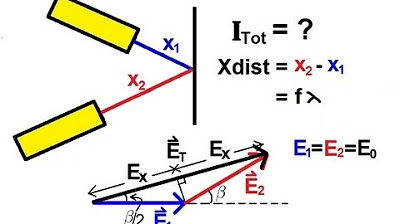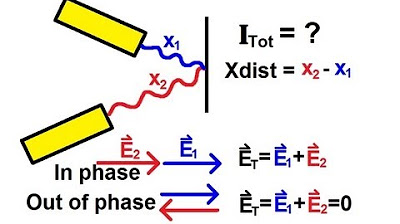Physics 60 Interference of Light (2 of 8) Path and Phase Difference
TLDRIn this lecture on light interference, the special case of beams with a quarter-wavelength phase difference is explored. When light waves are 90 degrees out of phase, their electric field oscillations are perpendicular, leading to a vector summation that results in an intensity twice that of a single beam. This is contrasted with the complete in-phase scenario, where intensity quadruples. The lecture promises a general case analysis in the next video, where any phase difference will be considered.
Takeaways
- 🌟 The lecture discusses a special case of light interference, focusing on the path length difference between two beams of light.
- 🔄 When two light beams are completely in phase, the combined intensity is four times the intensity of a single beam.
- 🚫 If the beams are 180 degrees or half a wavelength out of phase, the combined intensity is zero due to destructive interference.
- 🤔 The lecture poses a question about the intensity when the path difference is a quarter of a wavelength, which is a key concept for understanding partial interference.
- 📏 The concept of vector summation is introduced to explain the behavior of light waves that are 90 degrees out of phase.
- 📐 The electric field oscillations are represented as perpendicular vectors, e1 and e2, when the beams are 90 degrees out of phase.
- 🌀 The magnitude of the total electric field, e_total, is calculated using the Pythagorean theorem, resulting in √2 times the magnitude of e0.
- 🌡 The intensity of the combined beams is derived from the square of the total electric field, leading to an intensity of 2 times that of a single beam.
- 🔢 The formula for the intensity of electromagnetic radiation is provided, showing the relationship between electric field strength and intensity.
- 📚 The script explains that the intensity of two beams 90 degrees out of phase is twice the intensity of a single beam, contrasting with the case of complete phase alignment.
- 👀 The next part of the lecture will cover the general case of light interference, where the phase difference can be any angle, expanding on the concepts introduced.
Q & A
What is the subject of the lecture?
-The subject of the lecture is the interference of light, focusing on a special case of path length difference between two beams of light.
What happens when two beams of light are completely in phase?
-When two beams of light are completely in phase, the intensity of the combined beams is four times the intensity of either beam on its own.
What is the intensity of the combined beams when they are 180 degrees out of phase?
-When two beams of light are 180 degrees out of phase, the intensity of the combined beams is zero due to destructive interference.
What is the effect on intensity when the path difference between two beams is a quarter of a wavelength?
-When the path difference is a quarter of a wavelength, the beams are 90 degrees out of phase, and the intensity of the combined beams is twice the intensity of either beam on its own.
How is the vector summation of electric field oscillations used to determine the intensity of combined beams?
-The vector summation of electric field oscillations is used by adding the magnitudes of the electric fields of the two beams at right angles to each other, resulting in the total electric field intensity.
What is the magnitude of the electric field oscillation for each beam if they are in phase and have the same intensity?
-The magnitude of the electric field oscillation for each beam is equal to e_0, where e_0 is the amplitude of the individual beams.
How is the total electric field intensity calculated when two beams are 90 degrees out of phase?
-The total electric field intensity is calculated by taking the square root of the sum of the squares of the individual electric field magnitudes, which is sqrt(2) times e_0.
What is the formula for the intensity of electromagnetic radiation in terms of electric field strength?
-The intensity of electromagnetic radiation can be described by the formula (1 / (mu_0 * c)) * E^2, where mu_0 is the permeability of free space, c is the speed of light, and E is the electric field strength.
What is the relationship between the intensity of two beams combined at a 90-degree phase difference and the intensity of a single beam?
-The intensity of two beams combined at a 90-degree phase difference is twice the intensity of a single beam due to constructive interference.
What will be discussed in the next video regarding the interference of light?
-The next video will discuss the general case of the intensity of light when two beams interfere with each other with any arbitrary phase difference.
Why is the intensity of the combined beams when completely in phase different from when they are 90 degrees out of phase?
-The difference in intensity is due to the nature of constructive interference when completely in phase, which results in a maximum intensity, and destructive interference when 90 degrees out of phase, which results in a minimum intensity.
Outlines
🌟 Light Interference and Phase Difference
This paragraph introduces the topic of light interference, focusing on the special case of a quarter-wavelength phase difference between two beams of light. It explains that when beams are in phase, the combined intensity is four times that of a single beam, and when out of phase by 180 degrees, the intensity is zero. The main point discussed is the scenario where the path difference is a quarter of a wavelength, leading to an intensity that is twice that of a single beam when they interfere. The explanation involves vector summation of electric field oscillations, assuming the beams have the same intensity, frequency, and wavelength. The mathematical derivation concludes that the total intensity (I_total) is the square root of two times the intensity of a single beam (I), demonstrating a clear understanding of how phase differences affect the resulting intensity in light interference.
Mindmap
Keywords
💡Interference of Light
💡Path Length Difference
💡In Phase
💡Out of Phase
💡Vector Summation
💡Electric Field Oscillations
💡Phase Difference
💡Intensity
💡Wavelength
💡General Case
Highlights
Introduction to the lecture on interference of light, focusing on a special case of path length difference.
Explaining the concept of complete in-phase and out-of-phase light beams and their intensity when combined.
The intensity of light beams is four times when in phase and zero when 180 degrees out of phase.
Investigating the intensity when the path difference equals a quarter of a wavelength.
Using vector summation to analyze the electric field oscillations of light beams 90 degrees out of phase.
Describing the perpendicular alignment of electric field oscillations for beams 90 degrees out of phase.
Magnitude of electric field oscillations being equal when beams have the same intensity and frequency.
Calculating the total electric field intensity as the vector sum of two perpendicular oscillations.
Deriving the formula for total electric field intensity as the square root of the sum of squares of individual magnitudes.
Relating the total electric field intensity to the square root of two times the individual intensity.
Expressing the intensity of electromagnetic radiation in terms of its electric field strength.
Calculating the combined intensity of two beams 90 degrees out of phase.
The intensity of two beams 90 degrees out of phase is twice the intensity of a single beam.
Contrasting the intensity of beams when completely in phase versus 90 degrees out of phase.
Announcement of the next video covering the general case of light interference with arbitrary phase differences.
Transcripts
Browse More Related Video

Physics 60 Interference of Light (3 of 8) Path and Phase Difference: General Case

Physics 60 Interference of Light (1 of 8) Path and Phase Difference: Introduction

Physics 60 Interference of Light (8 of 8) Glass Plates

All of AQA Waves Explained - A Level Physics REVISION

Physics 60 Interference of Light (5 of 8) The Thin Film

Ep12 Flory Huggins Entropy and Enthalpy - UC San Diego - NANO 134 Darren Lipomi
5.0 / 5 (0 votes)
Thanks for rating: